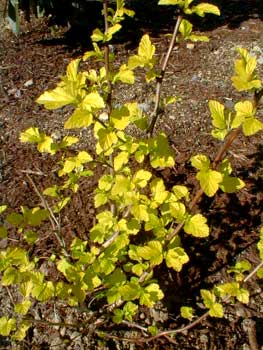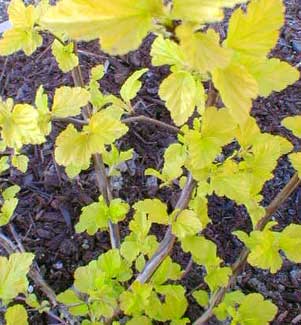
Dart's Golden Atlantic Ninebark
"Helen of Troy has sprung from Hell
To claim her ancient throne,
So we have bidden friends farewell
To follow her alone.
The Lady of the laurelled brow,
The Queen of pride and power,
Looks rather like a phantom now,
And rather like a flower."
-James Elroy Flecker
(1884-1915)
(1884-1915)
Dart's Golden Atlantic Ninebark (Physocarpus opulifolius var intermedus 'Dart's Gold') is perhaps two-thirds the size of shrubs from the western populations of wild ninebarks or such Pacific Ninebark cultivars as the popular black-leafed 'Monlo' aka 'Diablo.'
'Dart's Gold' is sometimes sold as a "dwarf" but that's a considerable exaggeration. 'Dart's Gold' & 'Luteus' are color variants of the east coast subspecies, & that subspecies is naturally more compact than Pacific ninebarks. Yet the gold forms even so easily grow to to five feet of height (taller specimens aren't out of the question) & can become wider than they are tall, compared to 'Diablo' which easily reaches seven or ten feet. Either one is a substantial rather than a dwarf shrub.
 Three-lobed leaves emerge golden in March & age to lime-green or chartreuse in summer, then back to yellow & bronzed red in autumn before leaf-fall reveals the upright twiggy structure with vertically-cracking exfoliating orange-brown bark on the oldest twigs.
Three-lobed leaves emerge golden in March & age to lime-green or chartreuse in summer, then back to yellow & bronzed red in autumn before leaf-fall reveals the upright twiggy structure with vertically-cracking exfoliating orange-brown bark on the oldest twigs.In June & July, the arching branches produce two-inch terminal pompoms of tiny white flowers with pink shimmer. These turn into red seeds about September, which are like another flowering, so that 'Dart's Gold' has multiple phases of beauty.
It thrives in sun but easily tolerates part shade. Ideal for zones 6 through 8, & with protection at the extremes, it can be grown from zones 3 to 9. It is not fussy about soil conditions, liking anything from rich & acidic to light & somewhat alkaline, so very adaptable & a good choice for difficult spots, even if moist acidic soil would be its greater preference.
Once established it can even be somewhat drought hardy, though to look its best it certainly prefers adequate moisture & periodic deep watering during droughty summers. When grown in organically rich soil it doesn't demand much in the way of fertilizing; a spring mulching with well-composted chicken manure would do more for it than chemical fertilizer. If it greatly likes its location it can sucker & form a thicket, though cultivars aren't as aggressive at suckering as are wild ninebarks.
Two small specimens were planted at a client's garden as the first of a series of new shrubs that were being arrayed around an 'Anah Krushke' rhododendron. The rhody had been suffering from too much sun exposure & it seemed a good idea to immediately protect the roots by shadowing those, using shrubs that in the long run will be large enough to shade more of the rhody.
'Dart's Gold' was planted on one side, the larger 'Diablo' behind the rhody, red & yellow-leafed 'Magic Carpet' dwarf spirea to the right & front, & blue-leafed 'Blue Mist' fothergilla closing the circle. After a year then two 'Anah Krushke' was well-defended within a circle of shrubs with unusual leaf-colors, while the rhody's leaves stand out from the center like an emerald in a baroque setting.
'Dart's Gold' can go years without pruning & I think it looks best allowed to go a bit wild. It certainly doesn't mind pruning to size, however, or even being taken down to the ground to start over. But if a percentage of the shrub is denied the opportunity to grow to its full length & maturity, the interesting exfoliating bark will never be seen. A pruned compact leafy shrub can look very nice spring through early autumn, but for winter beauty too, the tall fountaining oldest twigs with pealing bark are not going to be equalled by young stubby twigs of an often-pruned specimen.
For more selective refresher-pruning, a percentage of the oldest stems are usually taken down to the ground while preserving the young stems. But I'd save a third to half the old stems too for the sake of their pealing bark. Pruning can be done shortly after flowering when it is easy to judge which stems might be less well leafed thus most easily sacrificed, then again in late winter just before releafing when it is easier to assess it for shape & form. Sacrificed limbs should be removed clear to the base, but alternatively the whole shrub can just be shortened & it will do fine, so long as a truncated stubby look is satisfactory to the individual gardener's sensibility.